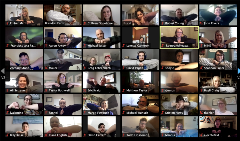I physically winced Sunday morning when my phone notified me my screen time report was available. One week into self-quarantine, I knew that average wasn’t going to make me proud.
My husband and I are very social people. Throughout an average week, we have more meals in our home with others than we do with just ourselves. And to comply with the CDC regulations and advice provided by our governor, in lieu of in-person company, we’ve turned to our phones for digital engagement on social media.
Even Forbes has christened COVID-19 as the “social media pandemic.”
While some are turning to social media for the latest information on the pandemic—and possibly falling into the dangers of reading and believing a string of Facebook comments — others are utilizing social media as a distraction, or a way to engage with their community through abnormal means like heavier texting, more social media engagement, phone calls, extended FaceTimes, downloading the Zoom app, etc.
A 2019 study by analytics company Zenith found adults spends an average of 3.5 hours using the internet on their smartphone each day. Reports by The Washington Post and The Dallas Morning News are finding the average screen report increased by 35% during most Americans first week of self-quarantine.
In addition to screen time, a former Nielsen study shows when consumers stay home amid broadly disruptive events, TV screen times also show a 60% increase, or more.
This isn’t inherently bad. If extra screen time is helping maintain social distance, continued connection within a community or providing needed distraction at the moment, go for it. We are in a unique situation and are fortunate to live during a time where we’re able to stay connected through our screens.
For brands, this means consumers are spending more time in front of screens than ever before. As consumers turn to their screens for connection or distraction, brands should be pivoting their current media strategy – and quickly. With increased screen times and the desire to stay connected and engaged, there is a unique opportunity for brands to curate that community and connection.

If a media plan doesn’t change quickly, a brand posting about their latest release of XYZ that consumers will have to go into a store that is currently “non-essential” could show a lack of empathy, and it would be better to simply go dark.
For example, we’re currently working with a gaming client who’s shifting all tournaments to their online hub to create a Twitch-inspired community of gamers that can still connect and drag race each other from a safe, digital distance.
Other clients, such as our spirits brands, are pivoting their strategies away from group or public activities and leaning into their audience being at home and trying to find creative ways to stay entertained and lubricated.
Listen to how your audience is adjusting their lives during this time. Read comments and messages, and have community and media managers track what consumers are posting. Then quickly adjust your media strategy to adapt to what they’re doing, and fill the void of what they’re missing.
We understand that it’s scary to think of spending more money during a time when usual sales are unusual. But thinking through these strategies now could not only mean a new line of business when this is over, but maintaining — or even growing — brand loyalty post-self-isolation.
